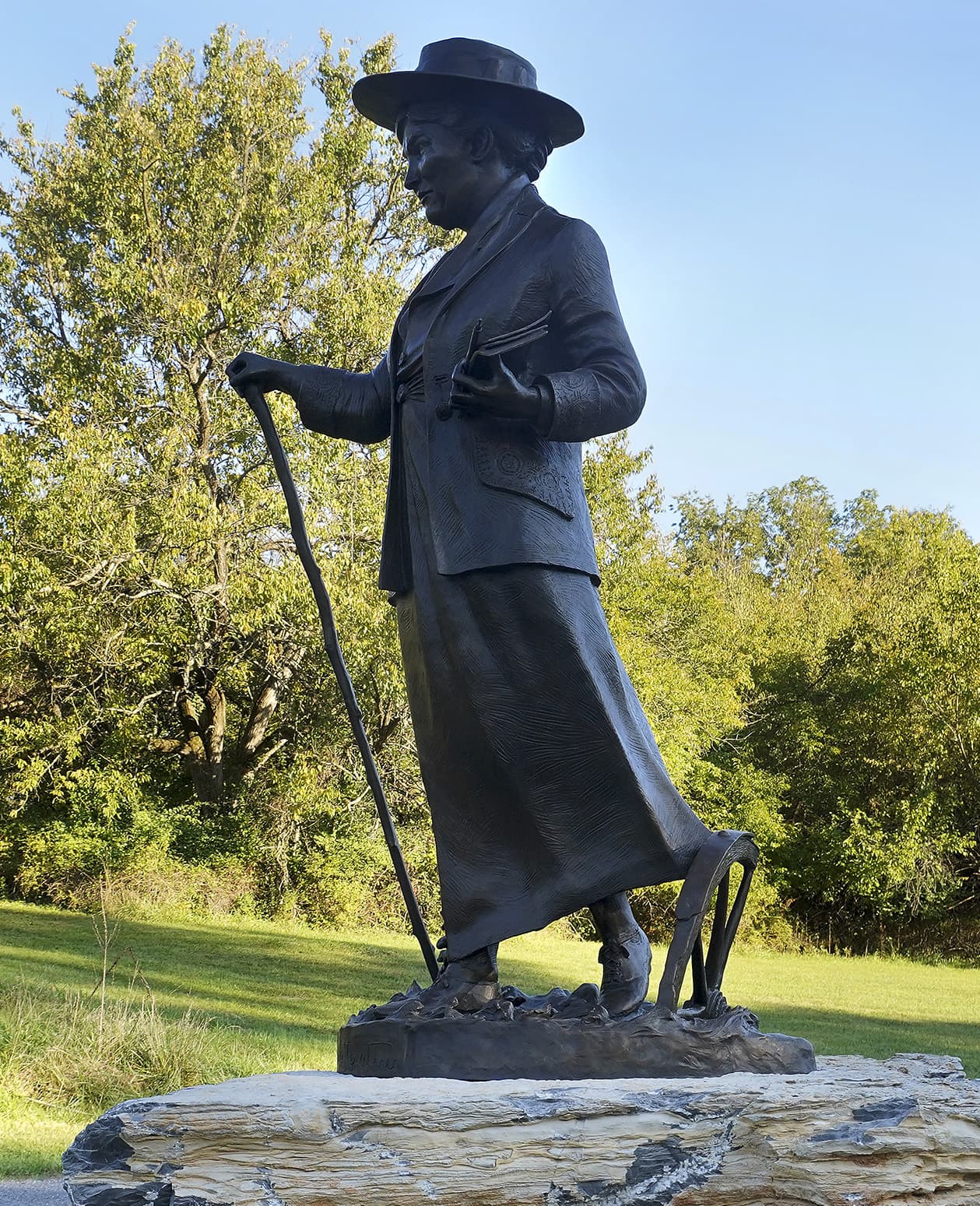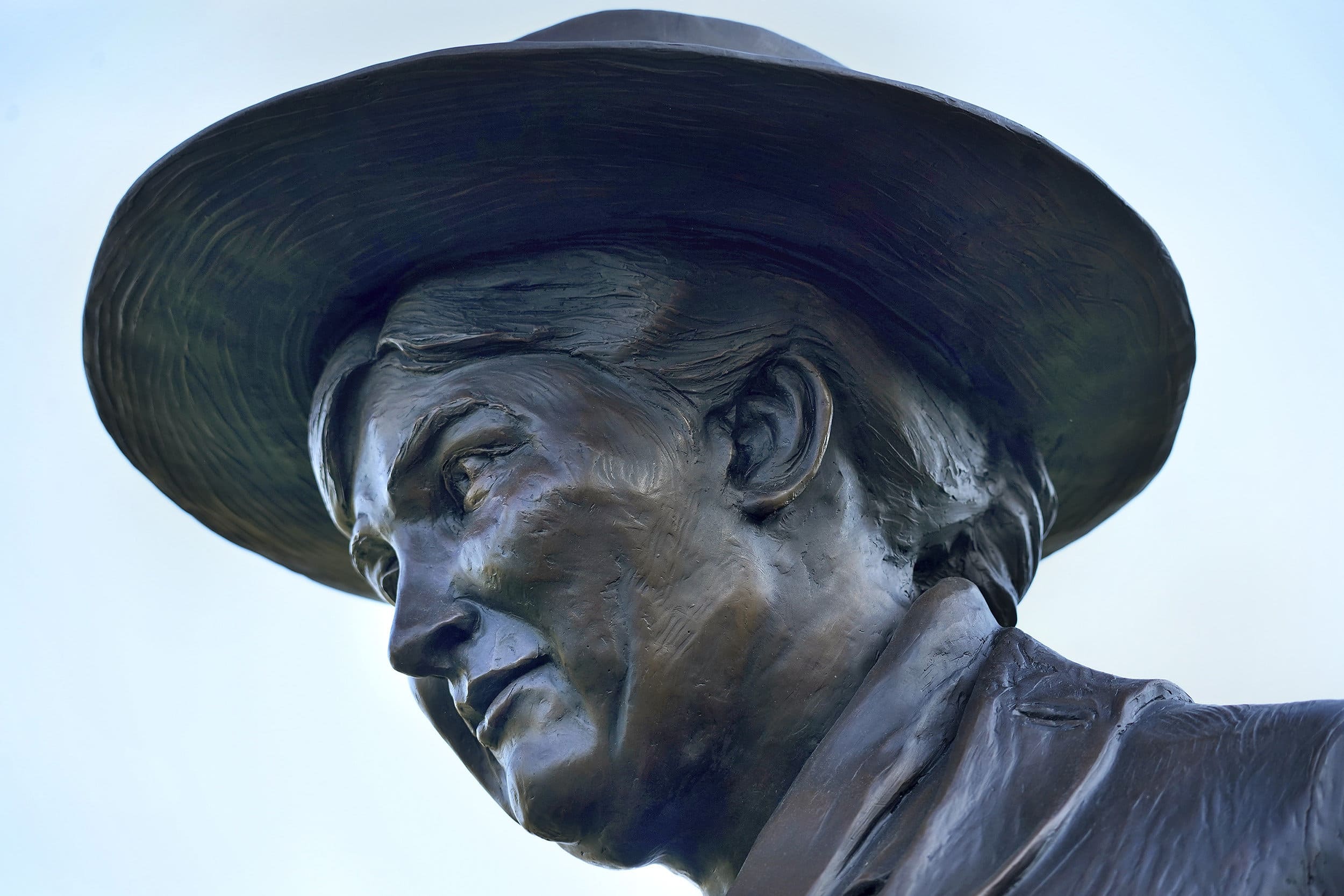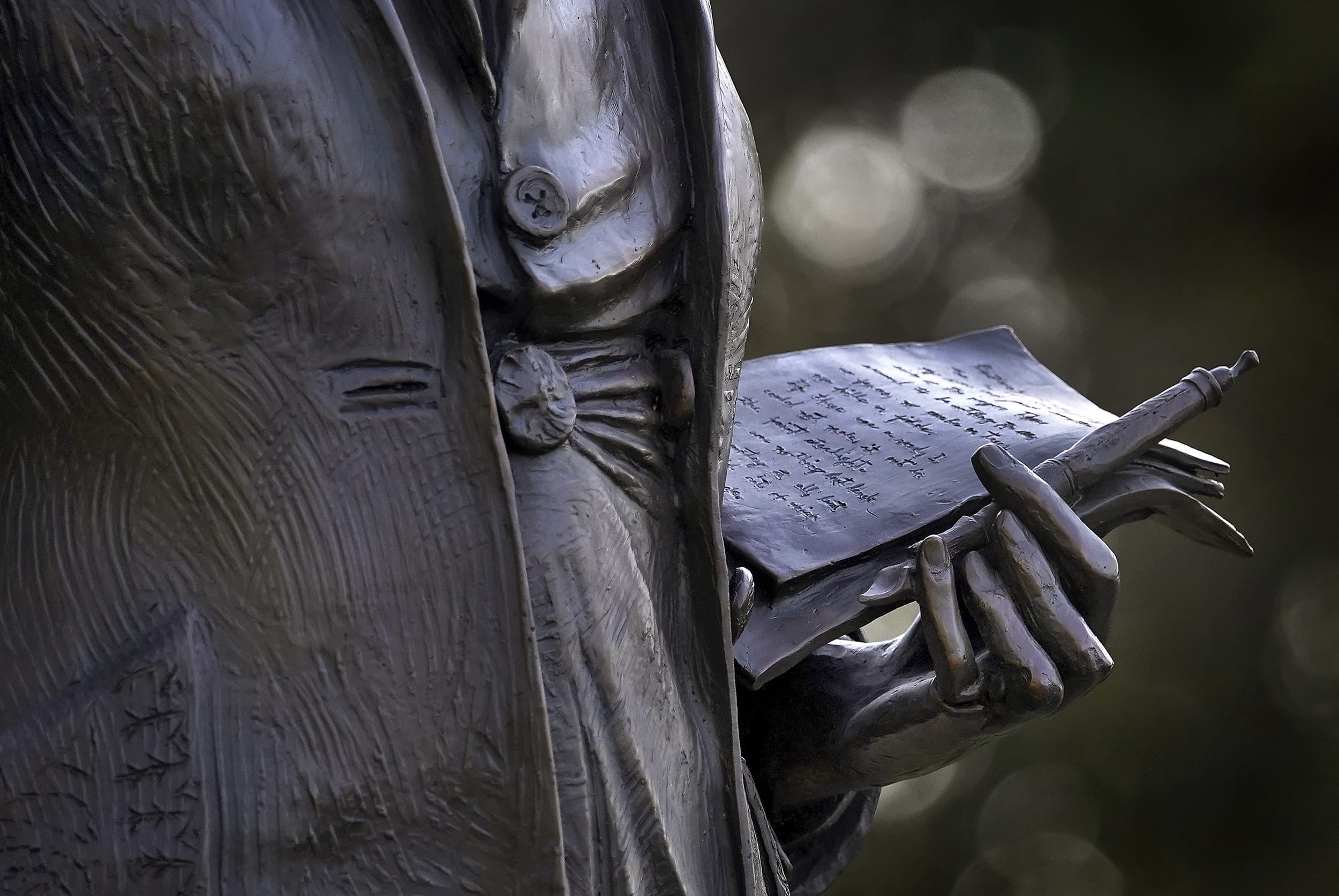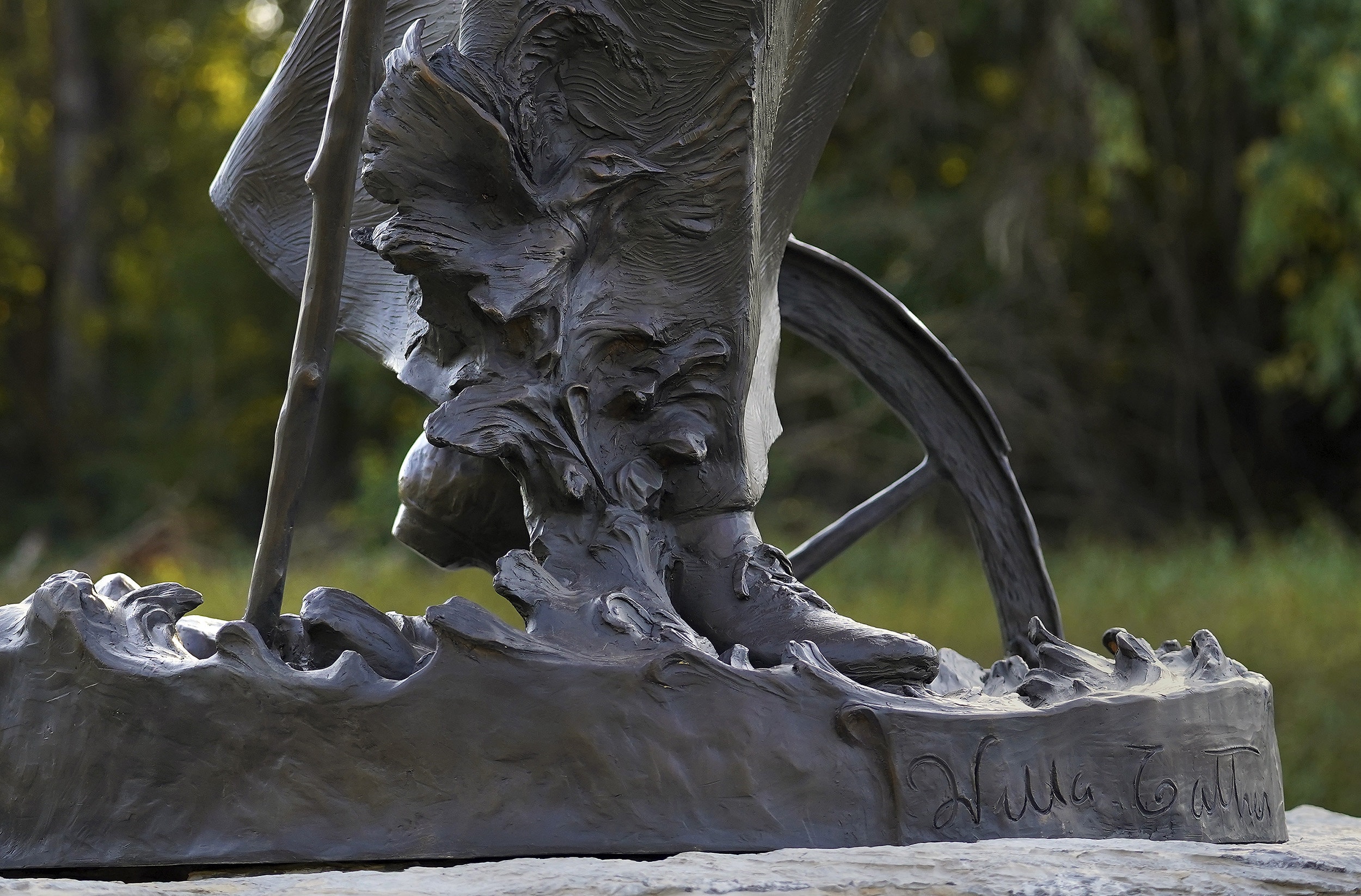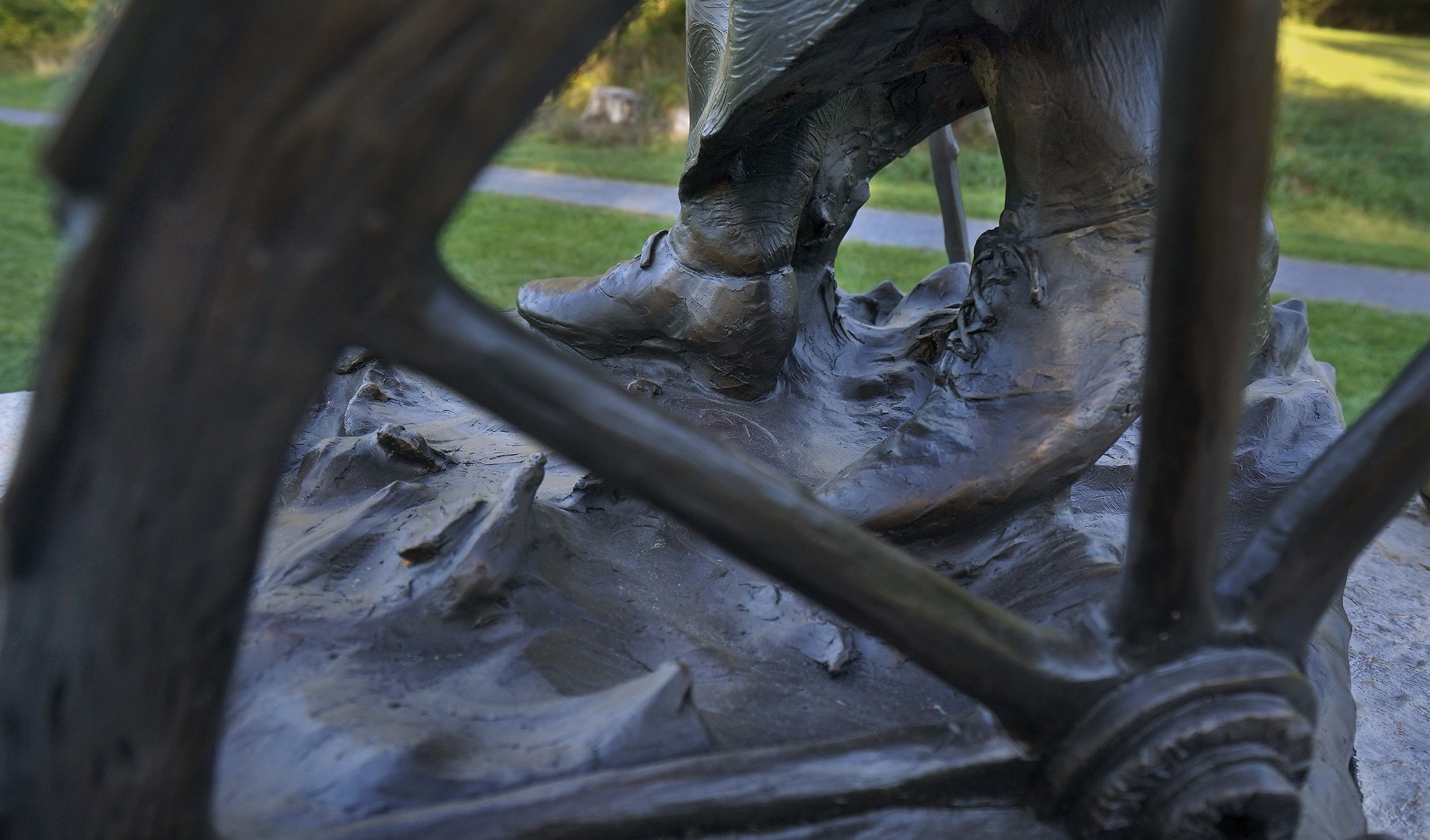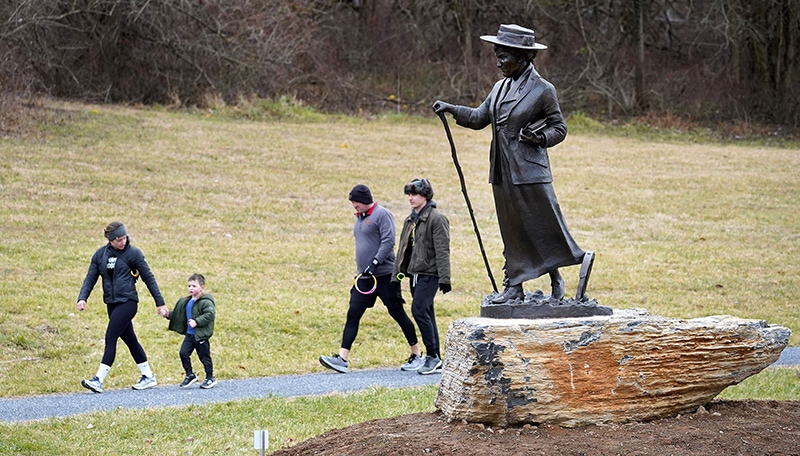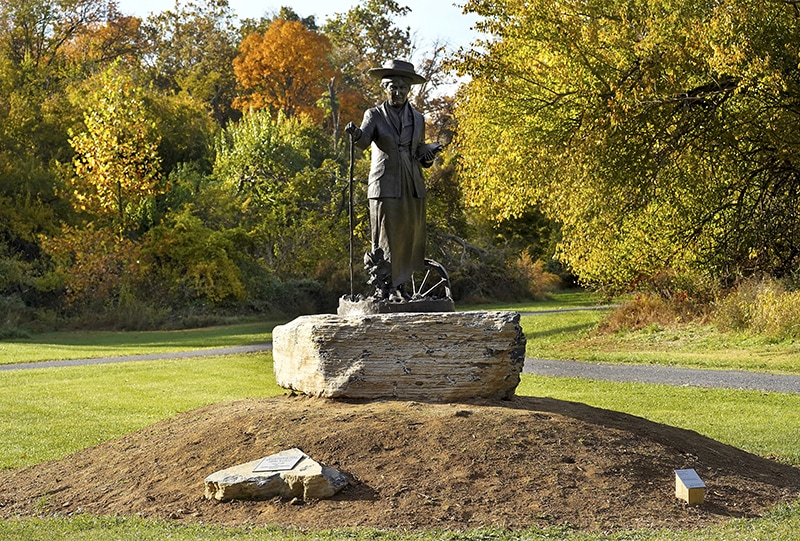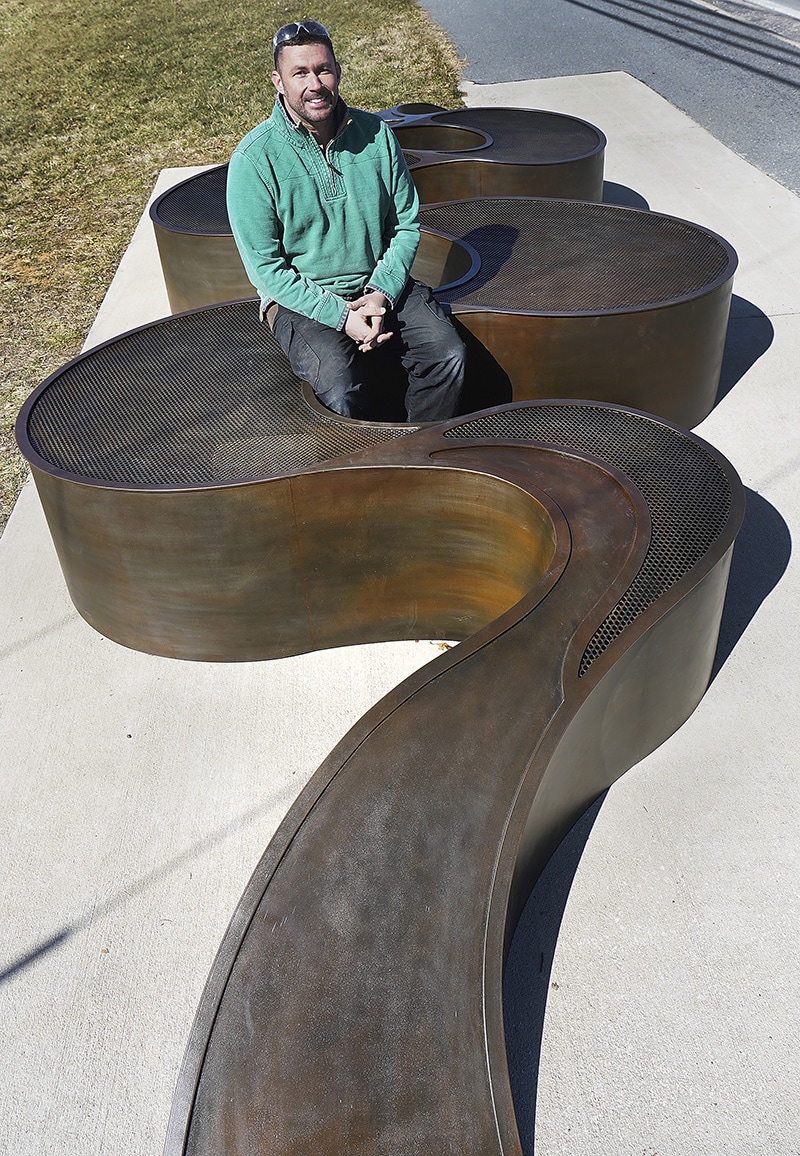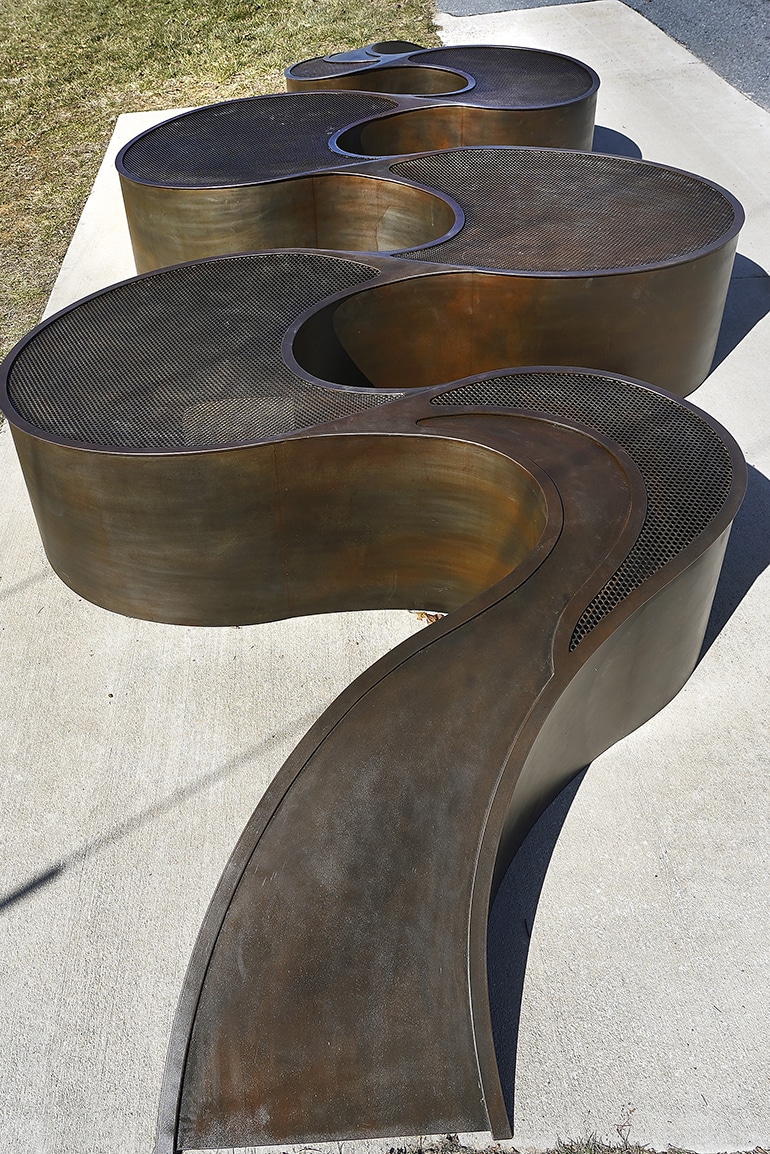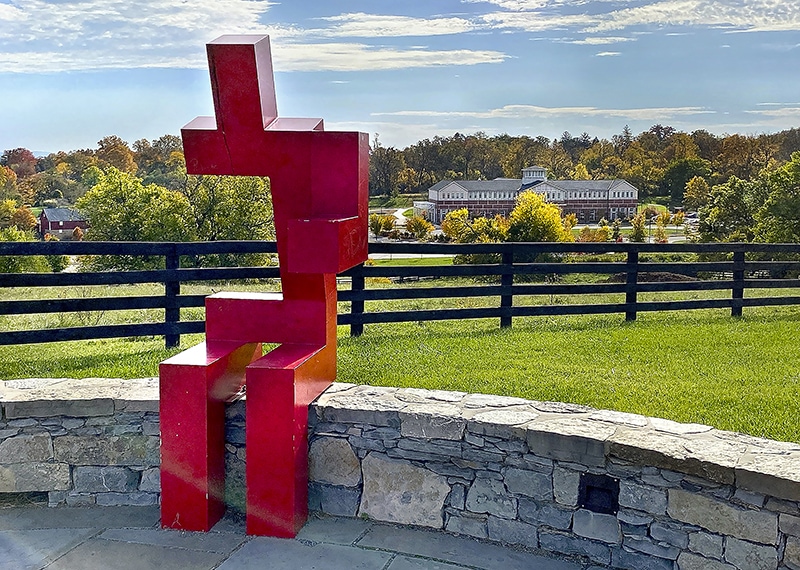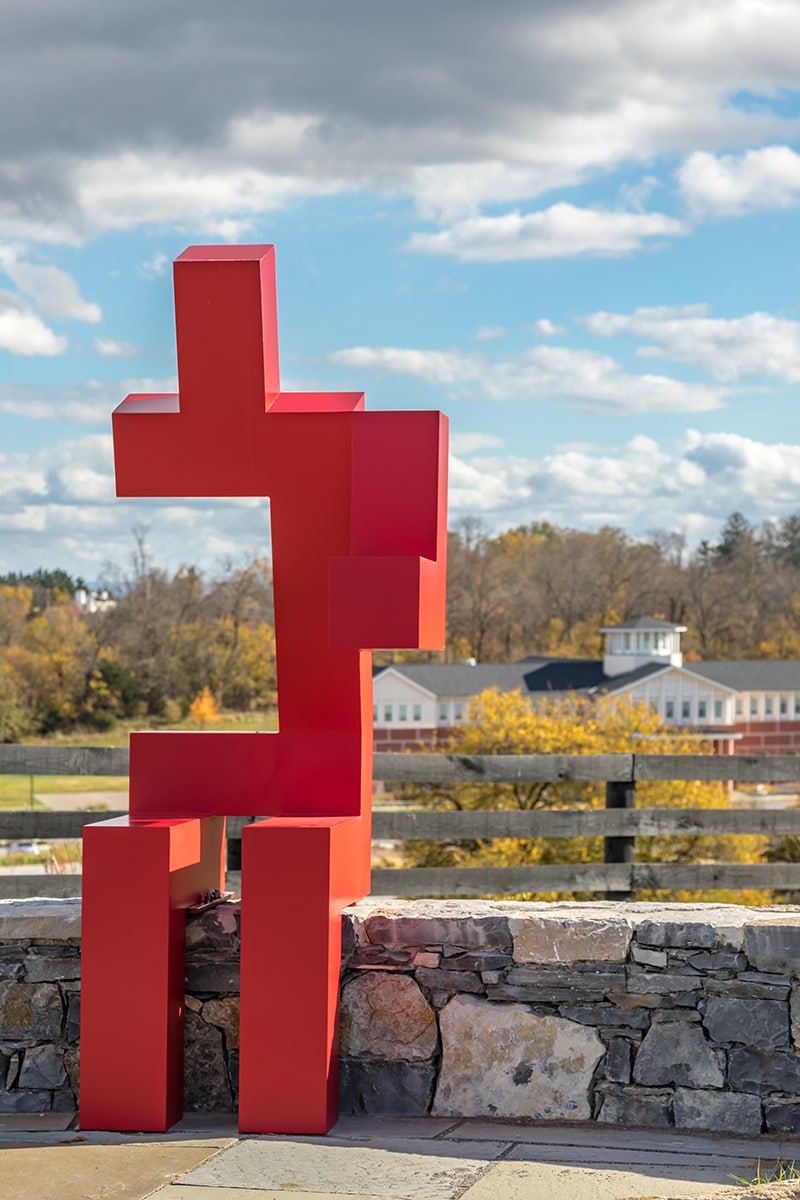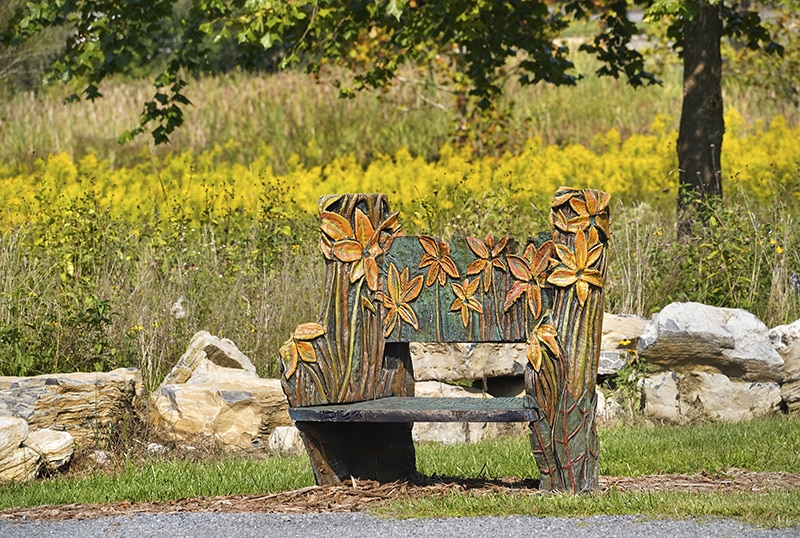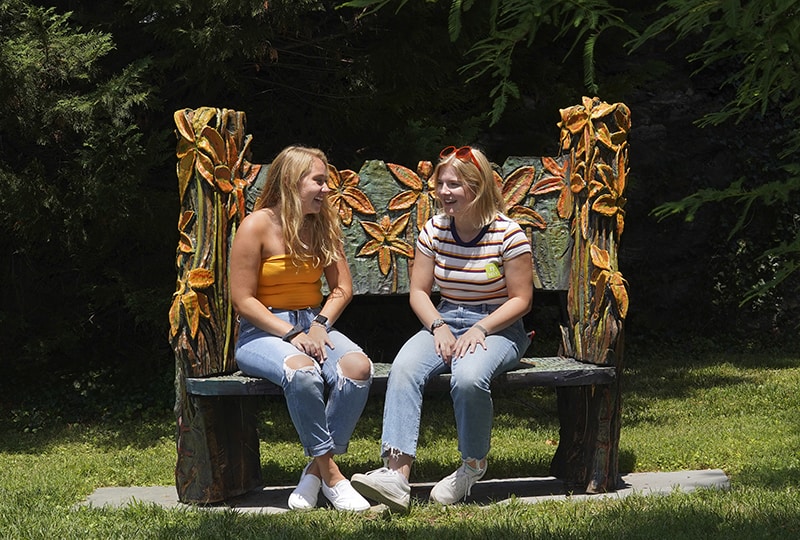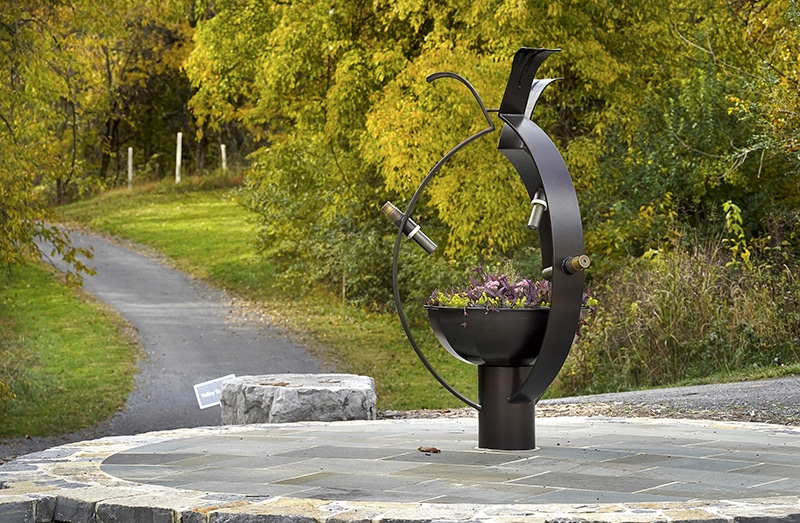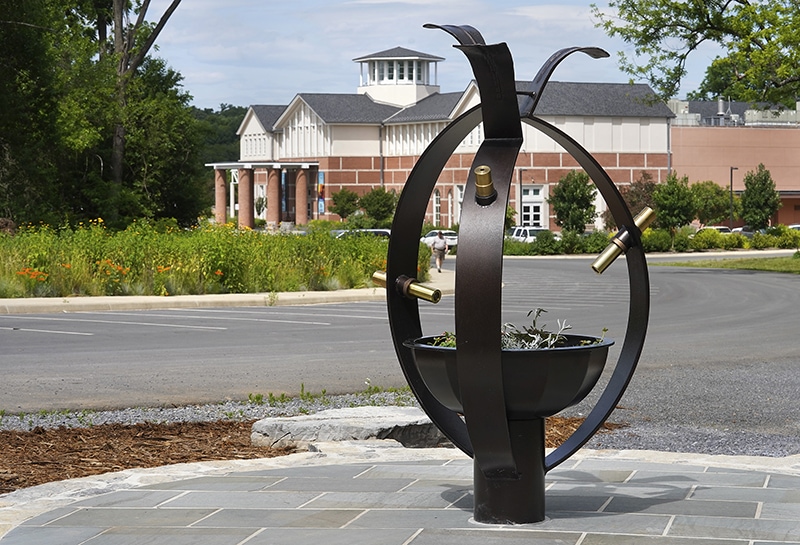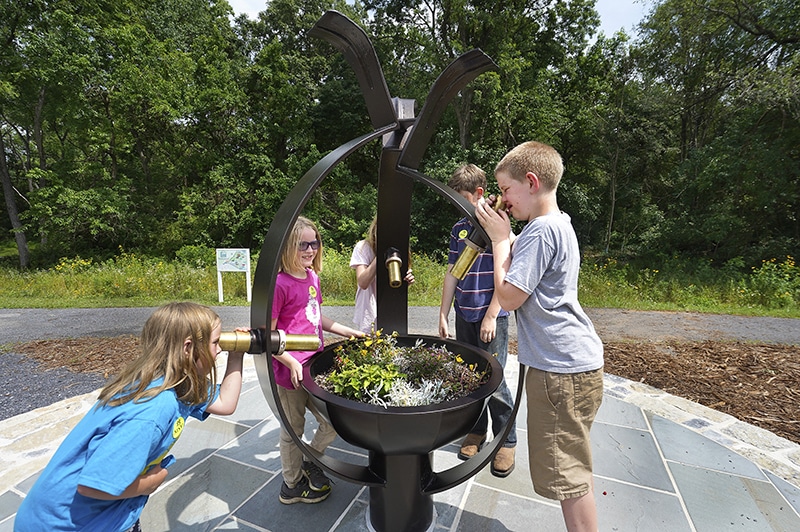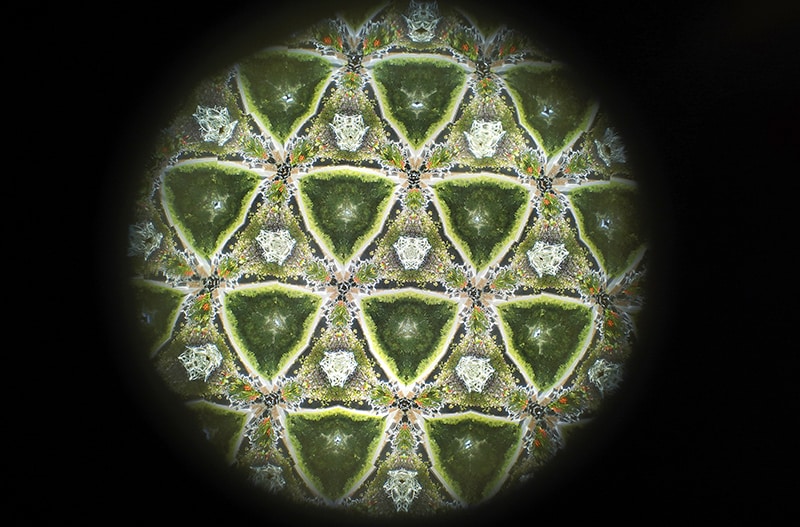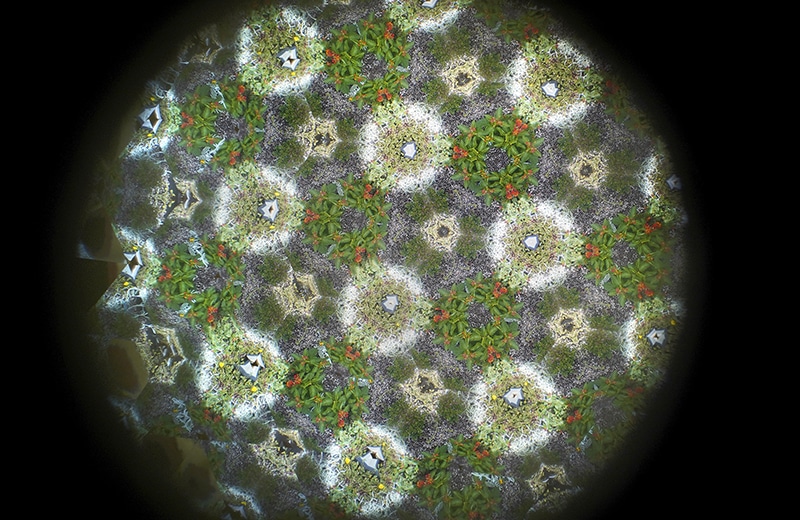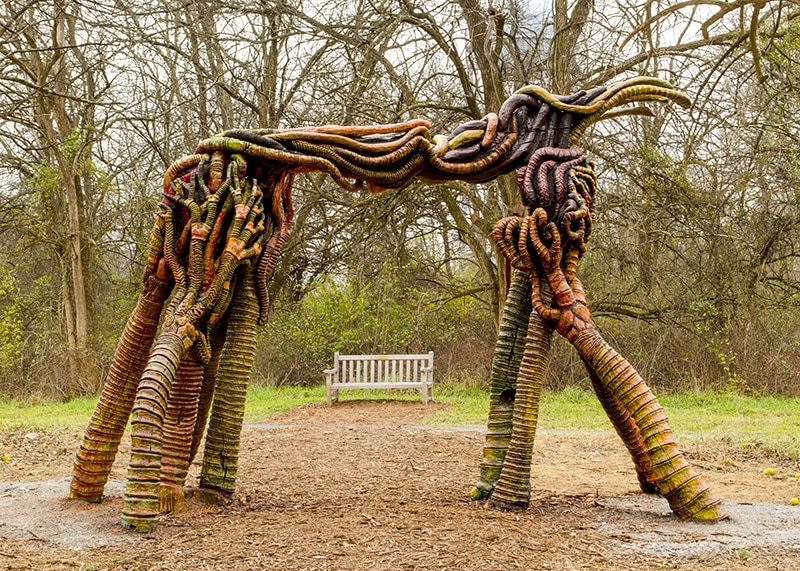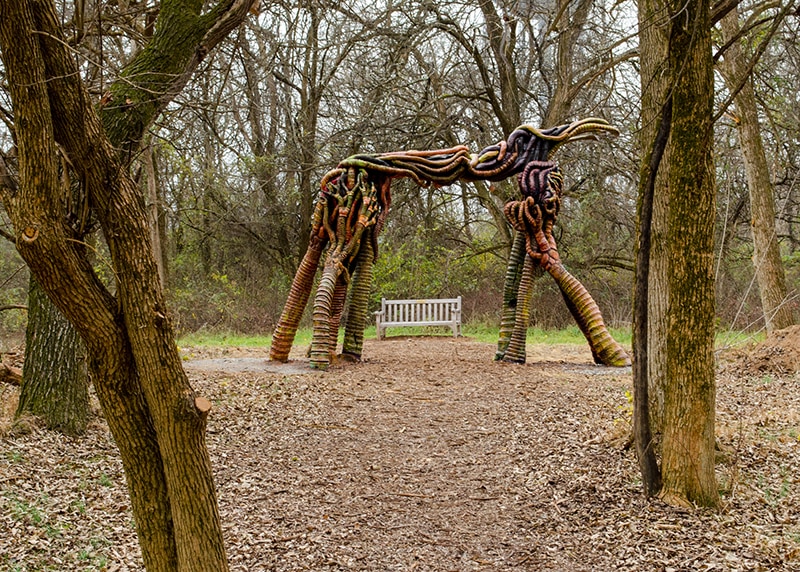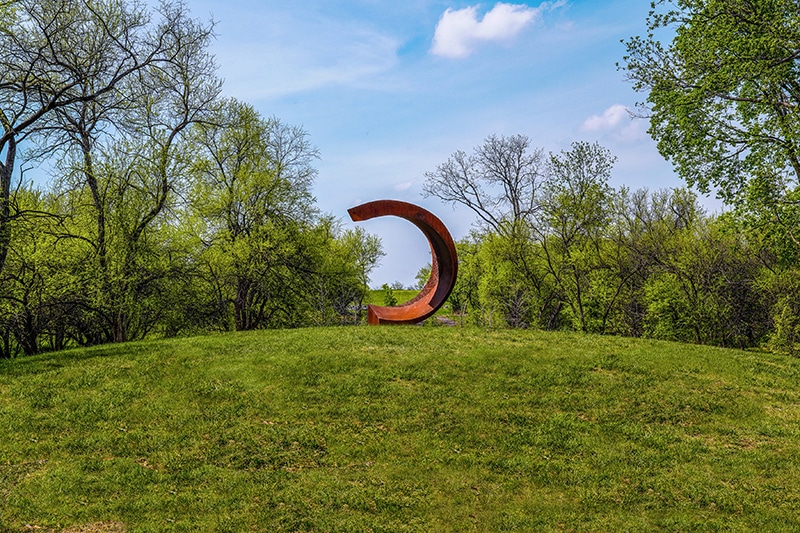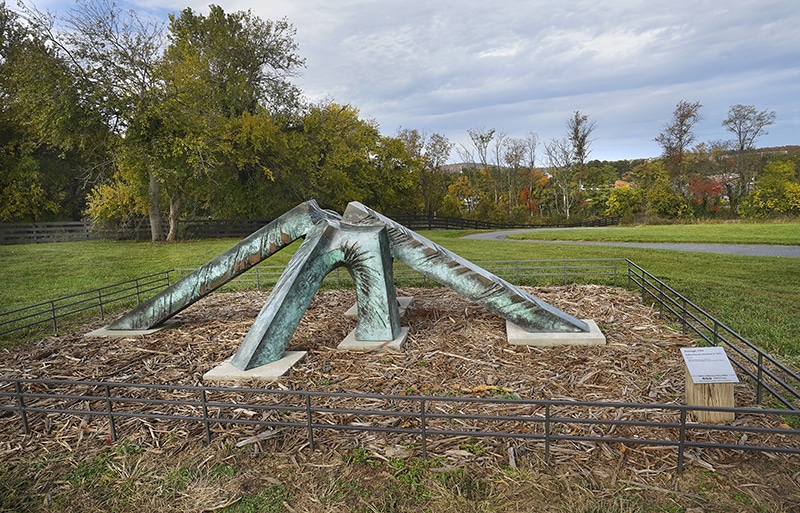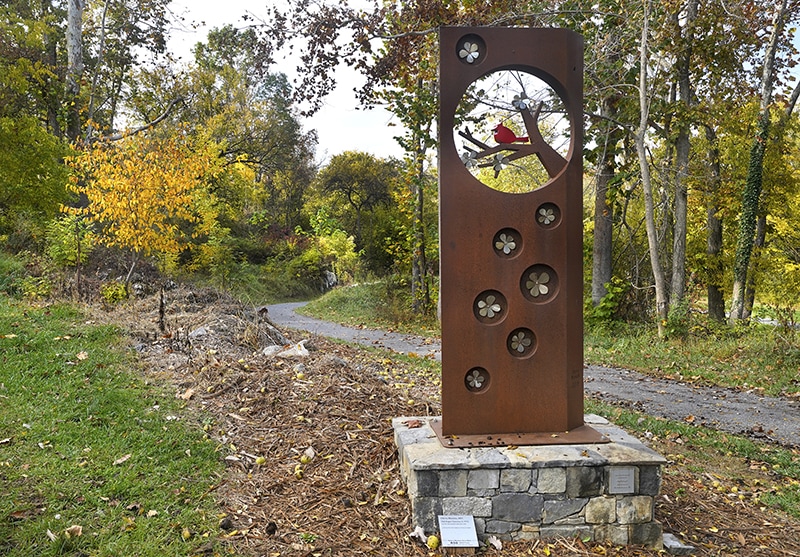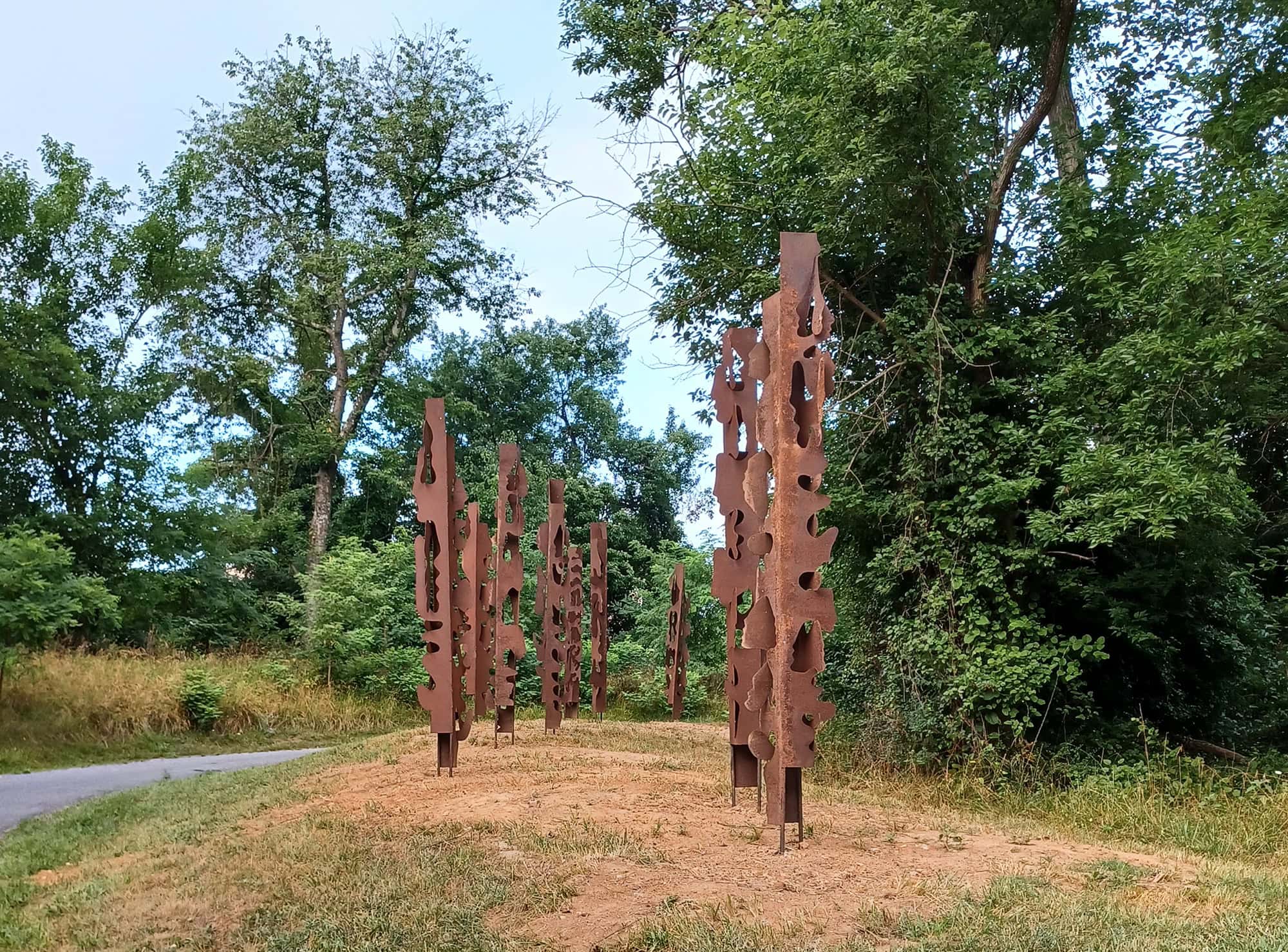Art on the Trails: Sculpture
A walk, run, or bicycle ride through The Trails at the MSV takes visitors by a variety of sculpture. Works range from a bench inspired by the seven bends of the Shenandoah to a garden kaleidoscope. With the support of generous donors, the MSV is actively growing its collection of outdoor works found in the park.
Use the menu on this page to see images of the sculpture and learn more about each piece.
Willa Cather, 2022
Littleton Alston (American, b. 1958).
Bronze
Given by John and Marjorie Lewis
In this sculpture, American author and Shenandoah Valley native Willa Sibert Cather (1873–1947), appears as if striding on her beloved prairie. Cather was born in 1873 in Back Creek Valley, Virginia, near Gore, in Frederick County. At the age of nine, Cather moved with her family to Nebraska, where they later settled in Red Cloud. After graduating from the University of Nebraska, she worked as an editor and journalist while writing poetry and short stories. In 1906 she settled in New York City, which became her home for the remainder of her life.
Much of Cather’s writing, including the novels O Pioneers! and My Ántonia, portray life as she experienced it while growing up in the grass country that surrounds Red Cloud. Other works include One of Ours (1922, for which she won the Pulitzer Prize), Death Comes for the Archbishop (1927), and Shadows on the Rock (1931). Her last novel, Sapphira and the Slave Girl (1940), is set in her native Virginia.
Artist Littleton Alston is also a Virginia native. In 2019, he won the commission to create a bronze sculpture of Cather to represent Nebraska in the National Statuary Hall Collection at the U.S. Capitol, the first African American artist to do so. The MSV sculpture is an additional cast from Alston’s original model for the Capitol Bronze. An additional casting was also created for the National Willa Cather Center in Red Cloud, Nebraska. Alston is currently Professor of Sculpture at Creighton University, Omaha, Nebraska.
Read more about the MSV Willa Cather sculpture in this media release.
Seven Bends of the Shenandoah River, 2021
Andrew White (American, 1981–2023)
Forged and fabricated steel
The bus stop bench outside the MSV entrance is a stylized rendition of the seven bends of the Shenandoah River. The work was designed and constructed by blacksmith/iron worker Andrew White. White was trained in European blacksmithing and metal working techniques and designed and created numerous staircases and balconies for interiors.
Compa Rojo (My Friend Red), 2019
Alejandro Martin Moreno Alonso “Otto” (Mexican American, b. 2000)
Stainless steel (type 304), ceramic automotive paint certified by BMW and Volkswagon
Museum purchase with funds from Carolyn and Allan Paterson and the Kuntz Foundation
For Compa Rojo, artist Alejandro Martin (or Otto) simplified the human figure as a series of rectangles defining head, shoulder, torso, left arm, and legs in an over-life-sized rendition. One of the most photographed works on the Trails, Compa Rojo is in the Paterson Overlook just off entrance road to the MSV. Based in Mexico City, Martin’s work includes three-dimensional representations of hashtags (#), dodecahedrons, and figures, among other shapes, all indebted to various forms of geometric abstraction of the early twentieth century.
Martin began making sculpture while still a high school student as an outgrowth of his means of earning extra money. His classmates paid him to do their homework for them. One assignment was to build a paper arch, and Martin ended up making several for his classmates. In the process, he fell in love with sculpture. He began making sculptures and selling them to friends. He later studied at the School of the Art Institute of Chicago and with the Mexican artist and educator Adriano Navarro Canedo. His work is in pubic and private collections in North and South America.
Daylily Slumber, 2018
Glenn Richardson (American, b. 1959)
Carved wood
Gift of the Amuse Art & Craft Fair
For artist Glenn Richardson, the work of art is the interface between the artist and the audience. When visitors to The Trails at the MSV rest on this bench, the bench becomes the means through which Richardson communicates with those visitors. Richardson partially carved Daylily Slumber during the 2018 Amuse Art & Craft Fair, held at the MSV. Daylily Slumber is located in a meadow near the Wetlands.
Emergence II, 2022
Robert C. Anderson (American, b. 1958)
Powder-coated mild steel, brass, glass
Stone terrace by Ben Smallwood (American, b. 1963)
Museum purchase with funds from Ilona and Bunny Benham who wished to provide an interactive piece intended to appeal to the child in all of us
Artist Robert C. Anderson noted this garden kaleidoscope was, “Inspired by the botanical growth process of plant life, suggesting that something new is about to emerge, like when a bud opens and becomes a beautiful bloom or when a bulb is planted and you see the new living plant emerge from the bare soil and develop into something beautiful.” Three arcing bands of steel cradle a bowl containing seasonal plantings. Three brass cylinders pierce the steel bands and hold kaleidoscope lenses through which guests can view faceted versions of the plants in the bowl. Both the bowl and the lenses turn to provide varied kaleidoscopic effects that change depending on the planting.
After an early career as a freshwater ecologist, Anderson had a job in which he learned to work with steel. His wife introduced him to kaleidoscopes, and Anderson’s garden kaleidoscopes were born. Since 1997, he has placed hundreds of similar kaleidoscopes in gardens and public spaces throughout the United States.
Oceans Beneath, 2020–2021
Glenn Richardson (American b. 1959)
Catalpa, sassafras, and eastern red cedar, acrylic latex paint
On the Forest Loop Trail on the south end of the Trails property stands Glenn Richardson’s Oceans Beneath. The artist described the archway at the entrance to the White Oak Turf Trail as representing prehistoric crinoids, marine creatures that can be found as fossils throughout the Valley. Richardson’s imagery ranges from the naturalistic to the wildly fantastic, but he makes all of it with an unexpected tool: a chainsaw, albeit a small one. It’s a tool he chose because it’s not traditionally used for art making, and Richardson is one who appreciates the unexpected.
Octavia, 2015
Beverly Pepper (American, 1922–2020)
Cor-ten steel
Museum purchase with funds from the Glass-Glen Burnie Foundation in memory of James T. Holland
Standing at just over 11 feet tall, Beverly Pepper’s Octavia appears to perch precariously on the ground. Made of Cor-ten (or weathered) steel, the piece is resistant to corrosion. Its rust-colored patina emerged within months of its fabrication. Melted steel dripped on in layers resulted in the textured areas.
American artist Beverly Pepper lived and worked in Italy for most of her adult life. There she was inspired by the monuments, buildings, and figures of antiquity. (Octavia is named for the older sister of Augustus, the first Roman Emperor.) Pepper hoped her works would have an ageless quality, similar to those of ancient monuments. Said the artist a few years before she made Octavia, “My influences are historical: Trajan’s column, Cleopatra’s obelisk, the Roman Forum, amphitheaters in Sicily, Greece, and Turkey. I focus on the present as projected from the past.”
Pentangle, 1982
Rubin Peacock (American, b. 1941)
Bronze
Virginia Museum of Fine Arts, Richmond, Gift of the Lipman Foundation in memory of Jeanette S. Lipman, 2017.251
Located off the Pasture Trail, Pentangle was made by Virginia-based artist Rubin Peacock. Pentangle, defined as a five-pointed star, features five “legs” with deep gouges, as well as a few circular glyphs suggesting carvings from an ancient civilization. Peacock utilizes a broad vocabulary of forms, from the heavy pillar-like “legs” in this work, to more upright shapes, both geometric and organic. Writers have noted that Peacock’s work often has a monumental presence, though the sculpture itself may be modestly proportioned.
Unlike many artists whose finished works are bronze, Peacock casts his own sculptures, pouring molten metal into molds, then painstakingly finishing and chemically coloring (patinating) the surface. Peacock lives and works primarily in Aylett and in Richmond.
Cherry Blossoms, 2015
Dale Rogers (American, b. 1972)
Core-Ten steel with stainless steel blossoms and painted steel cardinal
In memory of Bruce Allen Slaughter and Zemma Lee Slaughter
Artist Dale Rogers makes public art, much of it utilizing Cor-ten steel combined with stainless steel elements. Although the artist is based in Massachusetts, Cherry Blossoms, located on the Sycamore Trail, includes both Virginia’s state bird as well as a reference to the many flowering spring trees in the area. Rogers presents and sells much of his work at large craft fairs. He first showed Cherry Blossoms at the American Craft Council show in Baltimore, Maryland, in 2012. At the time, Rogers noted that 2012 happened to also be the centennial anniversary of Japan’s gift of the famous blossoming cherry trees to Washington, DC.
Charlie’s Lines, 2007
Charles Overman (American, 1941—2007)
Torch and/or laser cut Cor-ten steel
Gift of Suzanne Davis Rogerson
On the southwest corner of the Trails stand Charlie’s Lines by Charles Overman. Overman’s nomadic career took him for a time to the Pacific Northwest. There he carved totem poles with Native Americans, an experience that likely inspired the look of Charlie’s Lines. Born in North Carolina, Overman lived the final decades of his life in Page County, Virginia. As a young man he learned to work with steel in the shipyards of Tidewater, Virginia. Later experiences as a custodian at an art school in Philadelphia, and living among artists in New York, introduced him to the visual arts.
Please do not climb on the sculpture.
The Trails at the MSV is a 90-acre art park on the grounds of the Museum of the Shenandoah Valley. Notable sculpture, art installations, and landscape features are highlighted on the Trails map.
A free admission-art park, The Trails at the MSV is open daily from 7 a.m. to dusk.
